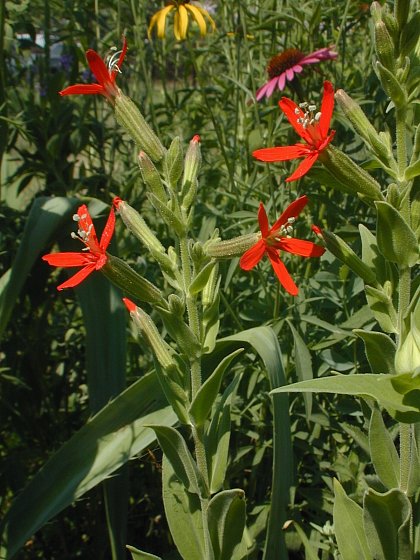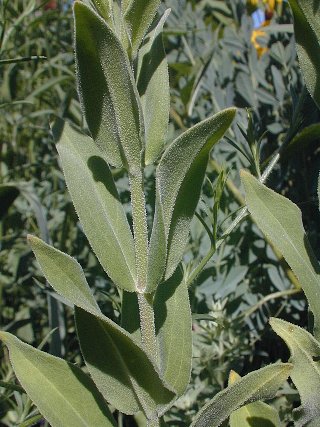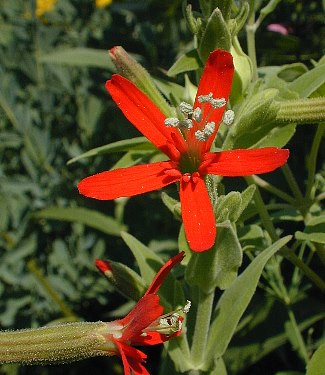Description: This herbaceous perennial plant is 2-3' tall and unbranched, except for the upper flowering stems. The stems are covered with fine white hairs, as are the leaves, on both the upper and lower sides. These leaves are up to 4" long and 2" wide, light to medium green, lanceolate to ovate, with a fuzzy texture and smooth edges. They occur in opposite pairs, rotating 90° degrees as they ascend the stem. Small clusters of bright red or scarlet flowers occur at the top of the plant. The star-shaped flowers have 5 narrow petals that flare abruptly outward from a long tubular calyx that is about 1" long. The flowers are about ¾–1" across, and have exerted stamens with grey anthers. The calyx is light green, longitudinally ridged, and covered with sticky hairs that trap climbing insects. The blooming period occurs from mid- to late summer and lasts about a month. There is no floral scent. The small black seeds usually fall only a short distance from the mother plant. The root system consists of a taproot.

Cultivation:
The
preference is full or partial sun in moist to slightly dry soil. The
soil can contain significant amounts of loam, clay-loam, or rocky
material. Royal Catchfly is fairly easy to grow, but it is somewhat
slower to develop than other plants and resents excessive shading.
During drought, the lower leaves may turn yellow and fall off the
plant. Plants begin to bloom while small in size, but it takes several
years to reach their full potential.
Range & Habitat:
The native Royal Catchfly occurs in widely scattered counties in
Illinois,
primarily in areas near Chicago, East St. Louis, and some SE counties
(see Distribution
Map). It is a rare plant that has endangered status in
Illinois. Habitats include mesic black soil prairies, openings in
upland forests, savannas, scrubby barrens, and open areas along
roadsides and railroads. Because this forb is showy and available
through the nursery trade, it has been introduced elsewhere around the
state in prairie restorations and flower gardens.

Faunal
Associations:
The nectar of the flowers attracts the larger butterflies, such as Papilio
polyxenes asterias (Black Swallowtail), and the Ruby-Throated
Hummingbird. Aphids suck juices from the upper stems occasionally.
There is little or no information regarding this plant's relationships
to birds and animals at the present time.
Photographic Location:
The photograph was taken at the webmaster's wildflower garden in
Urbana, Illinois.

Comments: Red is an uncommon color among prairie plants because many pollinating insects (e.g., bees) are insensitive to this range of the light spectrum. However, some butterflies perceive red, and for this reason are attracted to such flowers. The flowers of Royal Catchfly have a design that favors butterflies as pollinating agents: They have a proboscis that is sufficiently long to reach the nectar at the bottom of the long narrow tube that is formed by the calyx, while the flared petals provide a colorful landing platform for their legs. The only other plant that resembles Royal Catchfly in Illinois is Silene virginica (Fire Pink). This latter species also has bright red flowers, but the tips of its petals are slightly notched. Fire Pink is a shorter plant that occurs in and around woodland areas, often on clay or rocky banks, and is not found in prairies.